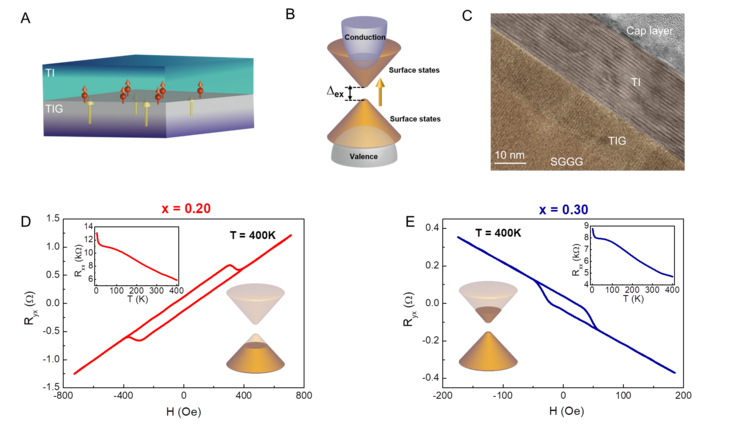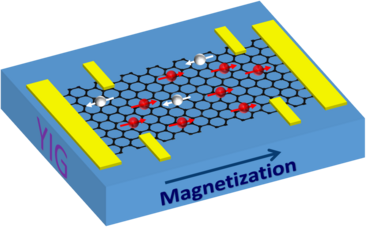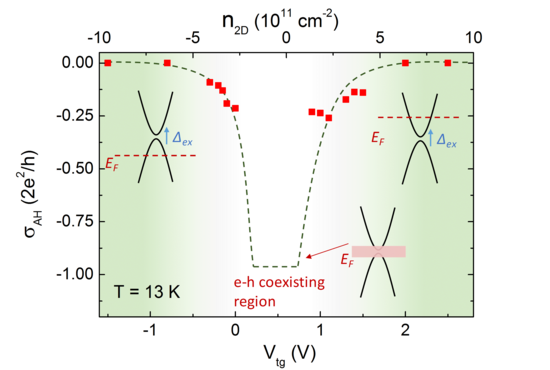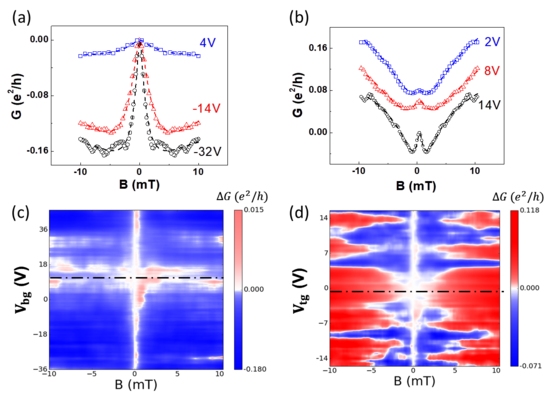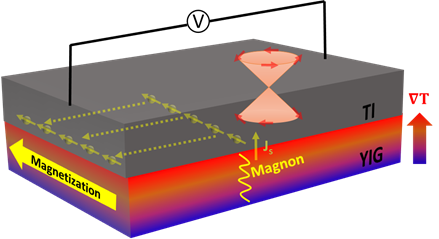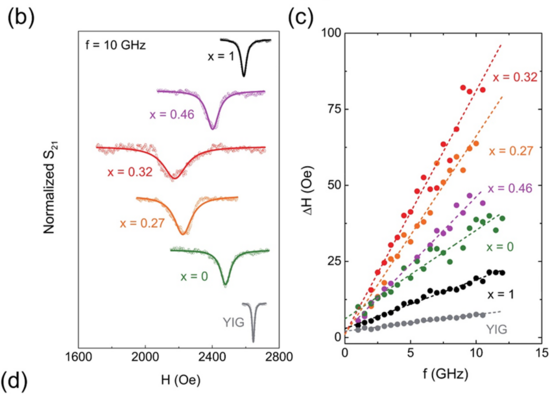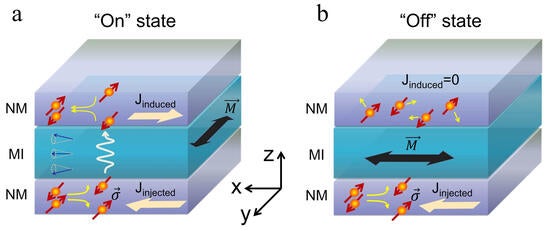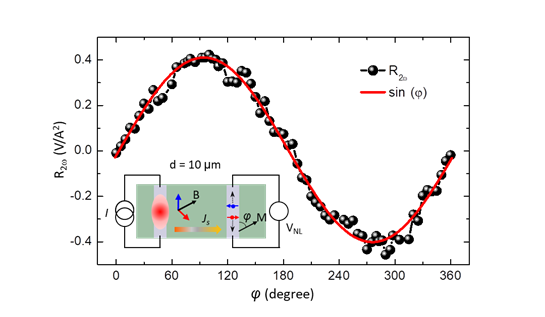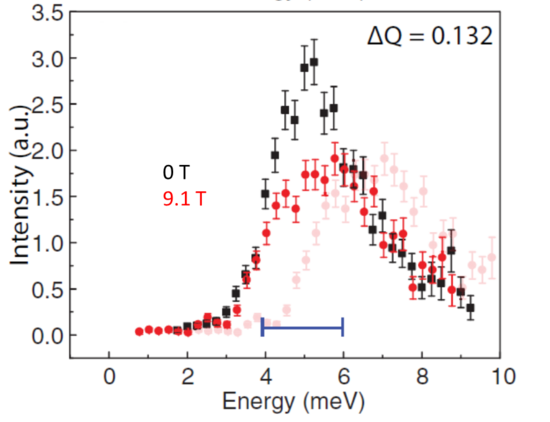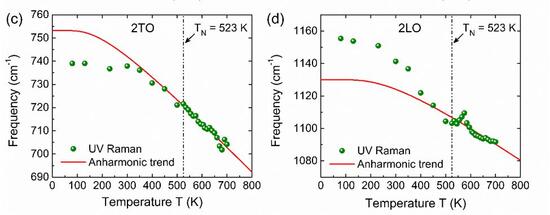Research
We are interested in studying novel physical phenomena in nanodevices and heterostructures arising from complex interactions such as spin-orbit interaction and exchange interaction. Some examples include induced ferromagnetic order due to proximity coupling, quantum anomalous Hall effect, spin-momentum locking in the surface states of topological insulators, spin-valley locking in transition metal dichalcogenides, etc. In addition, we also work on generation, manipulation, and detection of spin currents in ferromagnetic, ferrimagnetic, and antiferromagnetic materials. The techniques we employ in our research include:
- Laser molecular beam epitaxy for growth of high quality magnetic insulator thin films and heterostructures;
- Nanofabrication;
- Magneto-transport: from 50 mK to room temperature;
- Inelastic neutron scattering;
- Spin dynamics at GHz and THz frequencies
Research Highlights:
- Antiferromagnetic (AFM) spintronics
- Coherent spin current generation & detection via AFM spin pumping (Li et al, Nature, 2020)
Electrical detection of pure spin current from coherent magnons is demonstrated in the heterostructures of Cr2O3/heavy metal. Cr2O3 is a uniaxial antiferromagnetic insulator with the resonance frequency of 165 GHz. By sweeping the magnetic field with sub-terahertz (240 GHz) microwaves, we observed the spin currents generated by the AFM resonance and quasi-ferromagnetic resonance.
- Incoherent spin current generation & detection via AFM spin Seebeck effect (Li et al., Phys. Rev. Lett., 2019)
- Pure spin current generation & detection in AFMs (Yuan, Li, and Shi, Appl. Phys. Lett., 2020)
- Magnon-polarons in AFMs (Li et al., Phys. Rev. Lett. 2020)
- Single-domain Neel vector switching and electrical detection in Cr2O3 (Liao et al., Nano Lett. 2025)
2. Proximity-induced ferromagnetism: towards quantum anomalous Hall effect (QAHE)
- Above 400 K proximity-induced perpendicular ferromagnetic phase in TI surface (Tang et al., Science Advances, 2017)
This work has demonstrated strong proximity induced ferromagnetism in TI in a hetertostructures of Tm3Fe5O12 and (BixSb1-x)2Te3. The former is an epitaxially grown ferrimagnetic insulator film with the Curie temperature of 560 K and perpendicular magnetic anisotropy, and the latter is a topological insulator film with varying x which controls the position of the Fermi level. The anomalous Hall effect persists at 400 K.
- Proximity-induced ferromagnetism in graphene (Wang et al., Phys. Rev. Lett. 2015;Tang et al., APL Materials, 2017)
Graphene was predicted to develop a topological gap at the Dirac point and consequence to show QAHE if both exchange and Rashba spin-orbit interactions are both present. In these two papers, we demonstrated proximity-induced ferromagnetism in graphene up to room temperature.
- Proximity-induced Magneto-transport in Pt by 2D magnets (Lohmann et al. Nano Lett., 2019; Su et al., 2D Materials, 2020)
3. Proximity-enhanced spin-orbit coupling in van der Waals heterostructures (Yang et al., PRB RC, 2017; and Yang et al., 2D Materials, 2016; Yang et al. Nano Letters, 2018)
Graphene was predicted as the first 2D quantum spin Hall insulator, but the inherent spin-orbit coupling (SOC) is extremely weak. Transition metal dichalcogenides (TMD), on the other hand, have very strong SOC. In graphene/TMD heterostructures, three types of SOC can be induced: intrinsic or Kane-Mele, Rashba, and valley-Zeeman. In these two papers, we investigated the quantum transport properties and nature of induced SOC. The induced Rashba SOC can be as large as a few meV, two orders of magnitude greater than that in standalone graphene.
4. Physical consequences of spin-momentum locked surface states in topological insulators
- Greatly enhanced spin Seebeck effect in YIG/TI heterostructures (Jiang et al., Nat Comm. 2016)
Spin-charge conversion by topological surface states is found to depend strong on the Fermi level position. When it is in the bulk band gap and near the Dirac point, the conversion efficiency characterized by the longitudinal spin Seebeck current is greatly enhanced.
- Strongly modified spin dynamics of YIG in YIG/TI heterostructures (Tang et al., Science Advances, 2018)
In YIG/TI heterostructures, both Gilbert damping and magnetic anisotropy of YIG are greatly modified by the presence of the topological surface states of TI. As the Fermi level of the surface states is in the bulk bandgap and near the Dirac point, the Gilbert damping constant is 15 times larger than that of standalone YIG films. In addition, the induced in-plane anisotropy field is twice as large as the demagnetizing field.
5. Magnon-mediated current drag and magnon transport in magnetic insulators
- Magnon-mediated current drag in Pt/YIG/Pt(Ta) sandwich structures (Li, Xu et al., Nat. Comm. 2016)
Spin-charge interconversion occurs at two interfaces in Pt/YIG/Pt(Ta) sandwich structures that enables electrical signal transmission across an insulator. The nature of spin current transport manifests in the non-local electrical signal polarity reversal when Pt is replaced by Ta. Pt and Ta have opposite spin Hall angles.
- Long-distance magnon transport in antiferromagnetic Cr2O3 probed by non-local method (Yuan et al., Science Advances, 2018)
In Pt electrodes separated by distances up to 20 microns, non-local electrical signals are detected as an in-plane magnetic field is rotated. This non-local signal increases and saturates at low temperatures, indicating a very different magnon transport mechanism.
6. Spin-lattice interaction and magnon-phonon interaction
- Magnon-phonon interaction in yttrium iron garnet (YIG) probed by inelastic neutron scattering (Man, Shi et al., PRBRC, 2017)
The anomalies in spin Seebeck signals at two discrete magnetic fields were attributed to magnon-phonon interaction. At particular wave-vectors (q's), the magnon and phonon dispersion relations cross each other and the crossing points can be shifted in energy by applied magnetic field. This work examines a q-range with and without magnetic field and found enhanced scattering when the two dispersion relations cross.
- Spin-phonon interaction in NiO (Aytan et al., APL, 2017)
-
The energies of two Raman modes are affected by antiferromagnetism in NiO between the Neel temperature, one enhanced and one suppressed. Frozen spin-phonon interaction can be described by a coupling constant.

